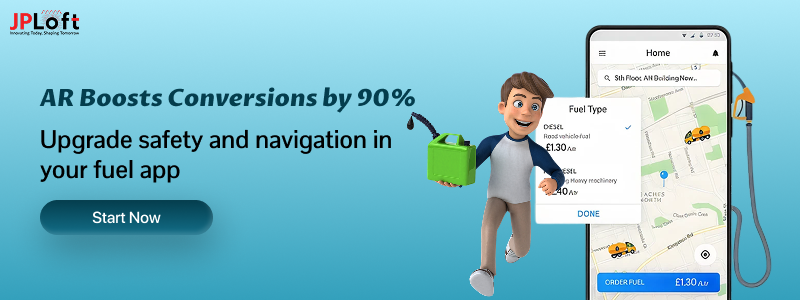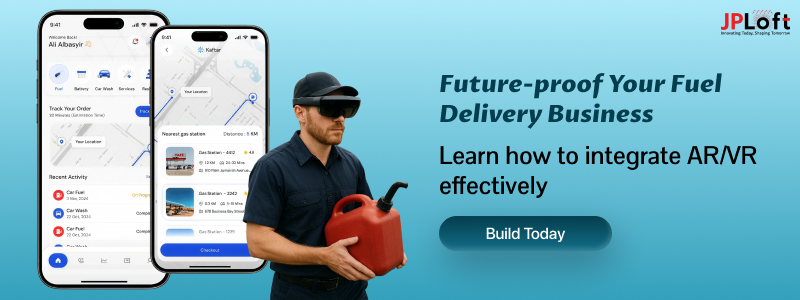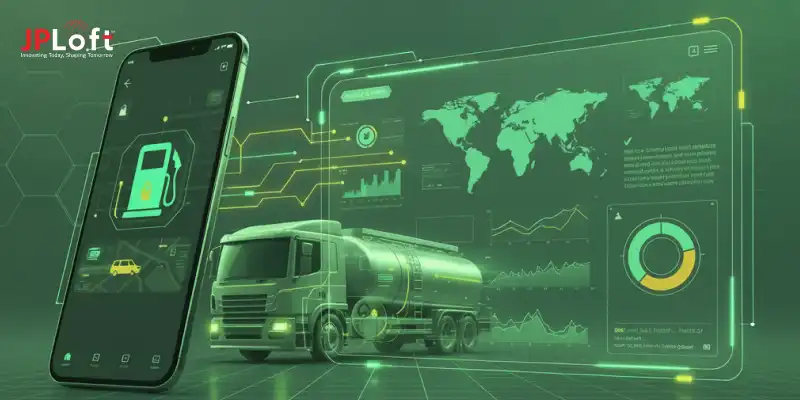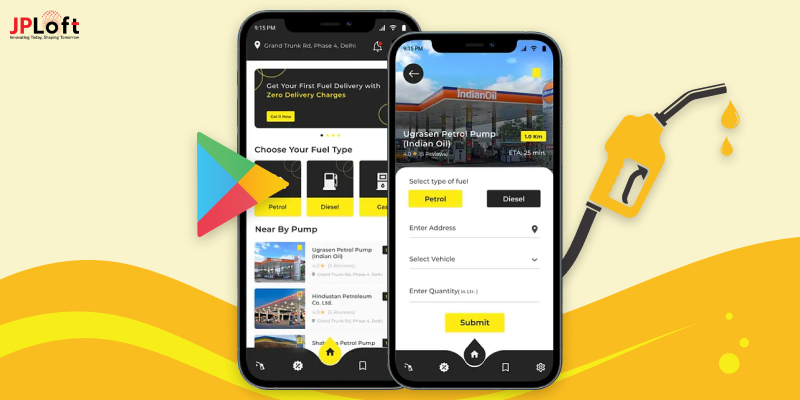Key Takeaways
AR/VR integration in fuel delivery apps improves last-mile navigation, reducing delivery errors and boosting customer satisfaction with real-time overlays.
VR-based training modules enhance driver readiness, cut onboarding costs, and ensure safer fuel handling across global operations.
AR safety overlays with compliance checklists and audit trails minimize risks and ensure adherence to hazmat regulations.
The process to implement AR/VR in fuel delivery apps should start with AR navigation, followed by VR training for cost efficiency and ROI.
Smart cities and IoT integration will expand AR/VR in fuel delivery apps, preparing businesses for autonomous vehicles and connected infrastructure.
JPLoft, a leading mobile app development company, offers end-to-end solutions for AR/VR-enabled fuel delivery apps, ensuring scalability, compliance, and future-readiness.
“The future belongs to those who prepare for it today.” – Malcolm X
This quote perfectly reflects the digital transformation in the fuel delivery industry. Entrepreneurs who embrace innovation early position themselves to win tomorrow’s market.
Additionally, the AR/VR market size growth is valued at USD 22.12 billion in 2024, and is expected to reach USD $96.32 billion by 2029; thus, there is a vast opportunity to grow.
With AR/VR revolutionizing navigation, safety, training, and customer experience, fuel delivery businesses can no longer afford to ignore immersive technologies.
If you’re wondering “how to integrate AR/VR in a fuel delivery app?”
You can integrate AR/VR in a fuel delivery app by defining use cases, selecting frameworks, building APIs, testing, and scaling deployments.
This blog is designed for founders, tech leaders, and enterprises aiming to modernize their fuel delivery operations with cutting-edge solutions.
We’ll walk through market insights, real-world applications, integration steps, costs, and challenges. Whether you’re scaling a fleet or launching a startup, AR/VR offers not just an upgrade but a competitive advantage that reshapes customer trust and operational efficiency.
Are you ready to proceed?
Market Trends and Contexts of Fuel Delivery App
Before you learn about the integration of AR/VR in a fuel delivery app, let’s evaluate the current market trends here.
The fuel delivery app simply refers to the apps that help users order fuel, such as petrol or diesel, for their vehicles, and have it delivered directly to their location, including home, website, or work.
-
According to the fuel delivery market statistics, the market is valued at USD 1622.27 million in 2023, which is predicted to reach USD 2859.37 million by the end of 2032.
-
The mobile fuel delivery market can grow from USD 5.84 billion in 2025 to USD 11.93 billion by 2035 at a CAGR of 7.4%. Additionally, the market is anticipated to expand from $5.5 billion in 2024 to $10 billion by 2034, growing at a CAGR of 6.1%.
-
Additionally, when we discuss augmented reality, the market is estimated to be USD 591.7 billion by 2033, and is further estimated to record a steady CAGR of 39.5% for the forecast period from 2024 to 2033.
-
The AR market is further expected to grow at an annual rate of 13.27% from 2023 to 2027, and they are reaching an estimated market size of US$2.05 billion in 2027.
-
The global VR market size is estimated at USD 59.96 billion in 2022, and is further projected to reach USD 435.36 billion by 2030, growing at a CAGR of 27.5%.
Learning about the current figures for AR/VR might have provided you with an estimate of how you can enhance the value of your app through integrating AR/VR, right?
Therefore, when you proceed to build a fuel delivery app, it's essential to go with the latest upgrades in technologies that can further help you boost the app’s presence in the competitive market.
Now, let’s figure out the impact or the role of AR/VR in the fuel delivery app in the following section.
Role of AR/VR in Fuel Delivery Apps
If you are the one who wants to follow the current fuel delivery app trends, then implementing the same in your fuel delivery app can be a wise solution.
Hence, let’s figure out the role of AR/VR in the fuel delivery apps and how it can help you to improve your app’s presence in the long run.
1. Improving Last-Mile Navigation
One of the most difficult tasks for drivers is finding the customer's vehicle location precisely, particularly in congested places or parking lots.
AR/VR enables fuel delivery apps to superimpose virtual arrows and markers onto the driver's camera, helping them navigate smoothly to the precise fueling location.
This not only saves time spent looking but also enhances customer satisfaction through quicker, more accurate service.
2. Enhancing Safety Through AR Overlays
Fuel delivery has stringent safety practices, such as maintaining ignition sources away and adhering to hazardous materials regulations.
With the addition of AR safety overlays, drivers have a real-time view of hazard areas, fueling procedures, and reminders directly from their devices.
If you’re researching how to integrate AR/VR in fuel delivery apps, this safety-first use case is one of the strongest justifications for adoption, as it minimizes risks during live operations.
3. Training and Simulation with VR
VR plays a strong role in operator and driver training. Rather than classroom teaching alone, fuel companies can utilize VR modules that mimic real-life situations such as spill control, fires, or equipment failure.
This provides a safe yet intense training environment, enabling drivers to acquire vital protocols more quickly.
VR training minimizes errors, enhances compliance, and gets teams ready for emergencies, which makes AR/VR integration in the development of fuel delivery apps an investment in efficiency as well as safety.
4. Enhancing Customer Experience with AR
From the user's point of view, AR is a game-changer. Think about aiming your phone camera at your parked vehicle and seeing where the fuel truck is going to stop immediately, or getting AR-based step-by-step fueling directions.
Users can even visually preview safety zones beforehand, keeping them at the proper distance.
By demonstrating transparency and control, AR/VR integration in fuel delivery apps builds customer trust and loyalty, which is vital in gaining long-term loyalty.
5. Compliance and Verification by Data-Driven
AR can also function as a compliance tool by documenting visual proof of finished safety checks. For instance, the app might insist drivers scan specific checkpoints or take short AR-tagged snapshots when they fuel up.
This leaves behind an immutable digital audit trail, and firms can then ensure compliance with safety and environmental rules.
When firms consider how to incorporate AR/VR into fuel delivery apps, integrating compliance into the process with immersive tech is a very pragmatic advantage.
6. New Monetization Streams
AR/VR integration not only streamlines operations but also creates new mobile app monetization methods to generate revenue.
VR driver training modules can be sold as a license to other logistics providers, while high-end AR safety features may be provided as part of subscription offerings to corporate fleets.
This monetization layer illustrates how AR/VR integration in fuel delivery mobile app development can go beyond customer service and become an extended business growth strategy.
7. Preparing for the Autonomous Future of Fueling
Looking forward, how to include AR/VR in fuel delivery apps will also overlap with new technologies such as autonomous trucks and drones.
AR may instruct autonomous fueling robots to exact fill locations, while VR control rooms may enable supervisors to monitor operations in immersive dashboards remotely.
Fuel delivery apps implementing AR/VR now will be well-positioned to grow into this future, where immersive interfaces will be normal for logistics management.
Key AR/VR Use Cases in Fuel Delivery Apps
Here is the list of the top fuel delivery apps that you need to consider when it comes to integrating AR/VR in the fuel delivery apps.
Case Study 1: CAFU — Precision Navigation with AR
What they do: CAFU has transformed fuel delivery in the UAE by allowing users to request on-demand fuel, car washes, and battery swaps directly through their app.
How AR/VR Could Be Integrated: By adding AR overlays, CAFU could guide drivers directly to a customer’s vehicle or fuel tank in complex areas such as multi-level parking lots or dense urban environments.
Additionally, this is an innovation that also influences the overall cost to develop an app like Cafu. For companies exploring how to integrate AR/VR in fuel delivery apps, this feature would greatly improve navigation accuracy and efficiency.
Impact if implemented: Reduced delivery errors, quicker service times, and a smoother customer experience through intuitive AR-based guidance.
Case Study 2: EzFill — AR-Enabled Safety Checklists
What they do: EzFill provides on-demand fueling services to residential users and commercial fleets through its mobile-first platform.
How AR/VR Could Be Integrated: EzFill could leverage AR to display real-time safety checklists during fueling operations, a feature that directly impacts the overall cost to create an app like Ezfill.
For example, instructions like “attach grounding cable” or “place spill tray” could appear as visual overlays on the driver’s device. This is a clear example of AR/VR integration in fuel delivery app workflows that strengthens operational compliance.
Impact if implemented: Fewer operational mistakes, streamlined safety verification, and stronger trust among both customers and regulators due to improved compliance monitoring.
Case Study 3: Yoshi — VR Training for Technicians
What they do: Yoshi offers app-based car services and virtual vehicle inspections, serving both individual drivers and fleet operators.
How AR/VR Could Be Integrated: Yoshi can implement VR simulations to train delivery technicians in handling hazardous materials, fuel spills, or emergencies, an advanced feature that influences the cost to develop an app like Yoshi.
When evaluating how to integrate AR/VR in fuel delivery apps, VR-based training stands out as a scalable way to prepare staff for real-world challenges without real-world risks.
Impact if implemented: Higher training effectiveness, safer operations in the field, reduced onboarding costs, and greater consistency in service delivery.
Learning about these case studies can help you in adopting and implementing AR/VR in the fuel delivery apps.
Now, let’s proceed with the steps to integrate AR/VR into the fuel delivery apps within the section given below.
What are the Steps to Integrate AR/VR into a Fuel Delivery App?
If you are starting with a fuel delivery app business, it's essential to adopt and implement the relevant steps.
Well, the steps to integrate AR/VR into a fuel delivery app can begin with establishing the integration goals, selecting an appropriate AR/VR framework, backend architecture, and asset development, along with an integration with mapping and IoT systems.
Additionally, you should test across the devices and scenarios before launching it to the public.
Now, let’s proceed with the integration steps below.
Step 1: Establish Integration Goals
Determine use cases: AR navigation, AR safety checklists, VR driver training, or customer-facing AR instructions.
Prioritize features depending on user requirements and ROI (e.g., compliance and safety overlays prior to VR training).
Determine whether the AR/VR modules are going to be add-ons to an existing app or part of a new development cycle.
Step 2: Select the Appropriate AR/VR Frameworks
For AR: ARKit (iOS), ARCore (Android), or cross-platform solutions such as Vuforia.
Device compatibility: Support mid-range Android/iOS devices and, if necessary, VR headsets such as Oculus Quest.
Integration strategy: Native SDKs for best performance or cross-platform SDKs for quick deployment.
Step 3: Backend Architecture & API Design
Create API endpoints for AR/VR data management (e.g., saving anchor points, safety checklists, training status).
Facilitate real-time communication through WebSockets or GraphQL subscriptions for AR navigation and VR training updates.
Develop a compliance and audit log system that logs AR-assisted fueling steps for regulatory inspection.
Provide cloud scalability (AWS, Azure, or GCP) to support high-volume AR/VR data.
Step 4: AR/VR Content & Asset Development
Develop 3D models for vehicles, fuel pumps, and safety zones.
Create AR markers/anchors for accurate overlays (e.g., QR tags at fueling locations or object detection for car fuel door openings).
Construct VR training scenarios that mimic fueling stations, emergencies, and spill response. Make assets optimized for low-latency rendering on mobile devices.
Step 5: Integration with Mapping & IoT Systems
Mapping APIs: Implement Google Maps or Mapbox with AR overlays for driver last-mile navigation.
IoT Integration: Integrate sensors (fuel tank levels, temperature, nozzle activity) with AR dashboards for live monitoring.
Make geofencing available to guarantee fuel delivery in safe and approved areas. Sync AR-based safety alerts with IoT-initiated alerts (e.g., high temp or spill detection).
Step 6: Apply Security & Compliance Layers
Encrypt all AR/VR session data in accordance with privacy regulations. Implement role-based access control (RBAC) for drivers, admins, and customers.
Incorporate checklist validation systems, such as insisting on AR photo verification prior to completing a safety step.
Ensure compliance with hazmat transport rules and regional fuel delivery safety legislation.
Step 7: Testing Across Devices & Scenarios
Here, you should conduct AR testing where it's all about testing overlays in various scenarios—day/night, multi-level parking, and low connectivity.
Now, let’s proceed with the VR testing, which is testing training modules for accuracy, user comfort, and motion sickness prevention.
Stress test backend APIs to guarantee smooth synchronization with AR/VR sessions. Add regression testing for the non-AR/VR modules to preclude any interruption in the core app operations.
Step 8: Deployment & Continuous Optimization
Deploy MVP AR/VR modules (begin with AR navigation and then scale to VR training). Collect user feedback on usability, accuracy, and performance.
Track KPIs like delivery time savings, compliance enhancements, or training completion percentages.
Optimize AR/VR models continually for performance and device battery usage.
Well, let’s figure out the technical requirements for adopting and integrating AR/VR in fuel delivery apps in the following section.
Technical Requirements for Integrating AR/VR in Fuel Delivery App
When you proceed to integrate AR/VR in the fuel delivery app, it's essential to adopt and select a relevant tech stack.
Hence, here is the list of fuel delivery app tech stack for integrating AR/VR.
► Supported Devices & OS Baselines
Target iOS (ARKit-enabled, iOS 15+) and Android (ARCore-enabled, Android 10+). Keep a certified device list for driver phones (rugged, decent cameras, gyro), and test battery/thermal thresholds when the AR session lasts long.
► AR SDKs & XR Frameworks
Implement ARKit (iOS) and ARCore (Android) for tracking, plane estimation, and anchors. For cross-platform or high-end features, use Unity/Unreal (XR Interaction Toolkit) and Vuforia for image/object targets—the basis of AR/VR integration in the fuel delivery applications.
► Mapping, VPS & Geolocation
Implement Google Maps/Mapbox for routing + geofencing. Use a Visual Positioning System (VPS) or photogrammetry assists (user-provided site photographs) to enhance last-meter precision where GPS is poor (garages, deep urban canyons).
► Anchors, Markers & Object Tracking
Set an anchoring strategy: QR/ArUco image targets around fill points, permanent cloud anchors for high-frequency serving sites, and optional 3D object detection for typical truck parts. This makes AR safety overlays consistent between sessions.
► 3D Assets & Content Pipeline
Create light 3D models (cones, no-smoke icons, hazard zones) and optimized textures (LOD, draw-call capping). Establish a content pipeline (GLB/GLTF) with CDN delivery and versioning so updates to AR content do not need to be done through app releases.
► VR Training Stack (High-ROI but Optional)
Develop VR modules in Unity/Unreal for hazmat processes, spill recovery, and emergency training. Export out to an LMS using xAPI/SCORM to prove competency—central to "how to integrate AR/VR in fuel delivery apps" for ops teams.
► Backend APIs & Data Contracts
Expose AR session log, cloud anchor, safety checklists, and incident report endpoints. Utilize GraphQL subscriptions or WebSockets for real-time state (driver proximity, check-off steps) and ensure idempotency on critical writes. Furthermore, you should go for API Integration for fuel delivery apps, helpful to improve the app’s performance.
► Realtime & Event Streaming
Utilize MQTT/Kafka or Pub/Sub for telemetry (position, sensor indicators, AR events). Store immutable audit trails (append-only, hash-chained) to meet compliance while allowing analytics on safety step follow-through.
► IoT & Sensor Integration
Ingest nozzle/open/close, tank level, and temperature sensors where available; display state in AR overlays (e.g., "bonding not detected"). Integrate AR warnings with IoT alarms for timely, context-aware advice.
Let’s summarize them and learn them all in the given table.
|
Category |
Requirement |
Details (2–3 lines) |
|
Devices & OS |
ARKit/ARCore support |
iOS 15+ and Android 10+ with certified devices for stable AR sessions. |
|
AR/VR Frameworks |
ARKit, ARCore, Unity, Unreal |
Use native SDKs for AR overlays; Unity/Unreal for VR training modules. |
|
Mapping & Geolocation |
Google Maps, VPS |
Combine GPS with visual positioning to enable accurate last-mile AR navigation. |
|
Anchors & Tracking |
Cloud anchors, QR markers |
Keep AR safety overlays stable using image targets or object tracking. |
|
3D Assets |
Optimized models |
Lightweight hazard zones, cones, and icons delivered via CDN for low latency. |
|
Backend & APIs |
Real-time APIs, WebSockets |
Store AR session logs, audit trails, and safety checklists; enable real-time sync. |
|
IoT Integration |
Sensor connectivity |
Overlay IoT alerts (tank levels, nozzle sensors) into AR interfaces. |
|
Security & Compliance |
RBAC, encrypted media |
Protect AR/VR data, enforce safety steps, and align with hazmat regulations. |
|
Performance & Testing |
FPS ≥30, field QA |
Test AR/VR in different lighting, weather, and network conditions. |
|
Accessibility & Safety |
Voice guidance, fallback UI |
Provide minimal AR text, voice prompts, and quick switch to 2D maps. |
|
DevOps & CI/CD |
Feature flags, asset pipelines |
Roll out AR/VR features gradually; enable remote updates to content/assets. |
|
Analytics & KPIs |
AR/VR usage tracking |
Measure delivery time savings, safety compliance, and VR training outcomes. |
After estimating the technological stack, let’s consider the overall cost in the mentioned section.
How Much Does it Cost to Integrate an AR/VR Fuel Delivery App?
The cost to integrate AR/VR in fuel delivery apps varies from $40,000 to $150,000. Here, you need to consider the factors such as complexity, feature set, and development region.
It generally takes $40,000–$80,000 to develop a basic fuel delivery MVP, whereas implementing AR/VR features will add 30–50% to the budget, taking overall costs to $70,000–$150,000. Advanced VR training modules or IoT-based AR overlays can take costs even further.
Costs vary by developer rates (US vs. Asia), 3D content demands, compliance modules, and testing requirements. Companies should deliberate staged rollouts, beginning with AR navigation or safety overlays, then ramping into VR training for balancing cost vs. ROI.
|
Factor |
Estimated Cost (USD) |
Details |
|
Core Fuel Delivery MVP |
$40,000 – $80,000 |
Basic features: ordering, tracking, payments, admin panel. |
|
AR Navigation Integration |
$15,000 – $25,000 |
GPS + ARKit/ARCore overlays for last-mile navigation. |
|
AR Safety Overlays |
$20,000 – $30,000 |
Anchors, hazard zones, compliance checklists. |
|
VR Training Modules |
$25,000 – $40,000 |
VR simulations for driver/operator training. |
|
3D Asset Development |
$5,000 – $15,000 |
Models of vehicles, pumps, hazard markers. |
|
Backend & IoT Integration |
$15,000 – $25,000 |
APIs, IoT sensors, real-time monitoring. |
|
Testing & Optimization |
$10,000 – $20,000 |
Multi-device AR/VR testing, compliance audits. |
The integration of AR/VR in fuel delivery apps will also impact the total cost to build a fuel delivery app.
Now, let’s switch to the challenges of adopting AR/VR in the fuel delivery apps within the section below.
What are the Challenges of Adopting AR/VR in Fuel Delivery Apps?
Identifying the challenges at the very first stage can help address issues that might result in fuel delivery app failure.
Hence, let’s proceed with the following list of challenges in fuel delivery apps for implementing AR/VR.
1. High Development & Implementation Expenses
AR/VR plays a major role in fuel delivery apps, yet integrating AR/VR demands talented developers, 3D modeling, and complex testing. Businesses considering incorporating AR/VR in fuel delivery apps should carefully consider upfront expenditures against long-term ROI.
2. Device Compatibility & Performance
Not every driver or customer is equipped with AR/VR-capable devices. ARKit (iOS) and ARCore (Android) support exists only on newer devices, limiting adoption. This puts friction into the process to implement AR/VR in a fuel delivery app, as companies need to either cap compatibility or spend on giving certified devices to drivers.
3. Safety & Regulatory Compliance
Fuel delivery contains dangerous substances, and integration with AR/VR should not divert operators from crucial operations. Making overlays, VR training, and AR checklists meet safety standards is a significant challenge. Companies venturing into using AR/VR in fuel delivery apps need to develop with safety-first in mind.
4. Difficult Test Environments
In contrast to traditional apps, AR/VR systems have to be tested under various real-world scenarios: dim light, dead zones for GPS, multi-level parking areas, or reflective surfaces. These parameters make it challenging to implement AR/VR in a fuel delivery app because stable tracking and overlay accuracy have to be continuously optimized.
5. User Adoption & Training
Even with tight technical implementation, customers and drivers might resist it. AR/VR's role in the success of fuel delivery apps hinges on user familiarity and training. Without adequate onboarding, users will view immersive aspects as irrelevant baggage rather than value-added features.
This is the list of the crucial challenges to include when it comes to adopting AR/VR in the fuel delivery apps.
Well, till now, we have learned about the market stats, role, case studies, steps, technical requirements, cost, and challenges.
Now, let's find out about the future scope of AR/VR in fuel delivery apps within the section stated below.
Scalability and Future of AR/VR in Fuel Delivery App
Whether you want to develop a cloud-based fuel delivery app or want to adopt AR/VR, then identifying the prospective future is crucial.
Now, let’s figure out the future of AR/VR in the presented section.
1] Scaling AR Navigation Systems
With advancements in AR technology, fuel delivery applications can extend navigation from smartphones to AR glasses and wearables. Companies looking at integrating AR/VR into fuel delivery applications will find benefits in hands-free navigation that allows for larger fleets and quicker deliveries.
2] VR Training Set to Become Standardized
The implementation process of AR/VR in fuel delivery applications will further involve VR-based compliance and safety training. VR-based training modules can be scaled to enable drivers to be onboarded efficiently in several regions at once, promote standardized standards, and minimize operational risks.
3] Integration with Autonomous and IoT Systems
Future-proofed fuel delivery apps will integrate AR/VR with IoT sensors and self-driving cars. Here, the procedure for integrating AR/VR into fuel delivery apps will consist of AR overlays for real-time hazard detection and VR dashboards for remote fleet monitoring.
4] Monetization Through Premium Features
Scalability also results from developing new lines of revenue. Firms learning how to incorporate AR/VR in fuel delivery applications can provide premium features, such as enhanced AR safety modules or VR-based compliance certifications, affording monetization while enhancing service.
5] Smart Cities Ecosystem Preparation
AR/VR in the future will seamlessly blend into smart city infrastructure. Implementation to introduce AR/VR in fuel delivery apps will follow along connected cars, AI-powered logistics, and city-scale AR navigation systems, creating scalability for next-generation urban fuel delivery.
Partner with JPLoft and Build Your Own App
Creating a sophisticated AR/VR-powered fuel delivery app demands not just technical know-how, but a profound understanding of the industry as well.
JPLoft, being a reputable Fuel Delivery App Development Company, has the expertise to craft bespoke, future-proof solutions designed specifically to meet your business objectives.
Whether it's creating intuitive booking interfaces or integrating sophisticated AR navigation and VR training modules, JPLoft delivers smooth development end to end. Our performance-driven, safety-focused, and compliance-oriented team will assist you in staying ahead of the competition.
As a startup looking to drive fast growth or an enterprise expanding operations, JPLoft provides scalable and cutting-edge applications that deliver results. Join forces with us now and turn your concept into a mature AR/VR fuel delivery app and open doors to new business opportunities.
Conclusion
AR/VR can turn a standard fuel delivery app into a safer, faster, and more trusted service. By layering AR for last-meter navigation and safety overlays, and using VR for realistic driver training, operators cut search time, boost compliance, and elevate the customer experience.
The path is clear: define use cases, pick ARKit/ARCore and a VR engine, design the backend and assets, integrate maps/IoT, test in real conditions, and iterate. While costs rise 30–50% over a basic MVP, staged rollouts and measurable KPIs protect ROI. With smart planning—and the right partner, you can future-proof operations and lead the market with immersive, scalable logistics.
FAQs
AR overlays navigation, hazards, and checklists onto real scenes; VR simulates training. Together they enhance safety, speed, and compliance across ordering, dispatch, and last-meter fueling.
Define use cases, pick ARKit/ARCore and Unity/Unreal, design APIs for anchors/logs, add Maps/VPS and IoT, implement RBAC/compliance, field-test in varied conditions, then roll out via feature flags.
Expect $70k–$150k including a fuel MVP, AR navigation, safety overlays, and basic VR training. Complexity, 3D assets, and region (US, UAE, India) significantly influence budgets and timelines.
Recent iPhones (ARKit) and Androids (ARCore) with gyro, good cameras, and strong CPUs. For VR training, Meta Quest-class headsets. Maintain a certified device list for fleets.
Yes—when designed safety-first. Use hands-free prompts, mandatory AR photo proofs, immutable audit logs, geofencing, and hazmat-aligned checklists to satisfy regional regulations and internal SOPs.
AR shortens time-to-vehicle and reduces fueling errors; VR accelerates onboarding and cuts incidents. Track delivery duration, checklist adherence, spill rates, and CSAT to quantify performance gains.













Share this blog